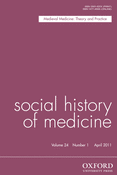-
Views
-
Cite
Cite
Edward Mullins, Esther Cohen, The Modulated Scream: Pain in Late Medieval Culture, Social History of Medicine, Volume 24, Issue 1, April 2011, Pages 209–210, https://doi.org/10.1093/shm/hkr039
Close - Share Icon Share
Extract
Esther Cohen observes that ‘though almost everybody knows what pain feels like, general definitions are difficult and unsatisfactory. No one has succeeded in providing a definition of bodily pain that is in any way helpful in understanding it’ (p. 2). This statement encapsulates one of the basic assumptions of Cohen's book: namely, that the immediate qualitative sensuality of pain is unknowable to anyone other than the subject of pain. Hence, she goes on to state ‘[t]his book is not about pain in the Middle Ages, for pain itself cannot be known; it is about what people thought and did about pain, how they conceptualized it, how they explained it to themselves and others’ (p. 3).
She identifies four discourses which provide a range of insights into how late medieval Europeans thought about, and conceptualised, pain: medicine, law, scholastic theology and devotional writing (the latter two of which overlap in important respects). Furthermore, she splits her book into two key discussion topics: the uses of suffering and knowledge from pain. In this way, she explores, first, the ways in which pain was considered useful by physicians and surgeons, jurists, scholastic theologians and the authors and subjects of devotional writings. For instance, pain was considered useful by physicians as a means of diagnosis, for jurists as a means of securing confessions of criminality, heresy and later witchcraft, from suspects, and for scholastic theologians, ascetics and mystics as a means of moral self-improvement. Secondly, she examines what kinds of information these groups of people found in pain or believed they could gain by causing it, to others in the case of jurists, and sometimes themselves in the case of ascetics and mystics.




